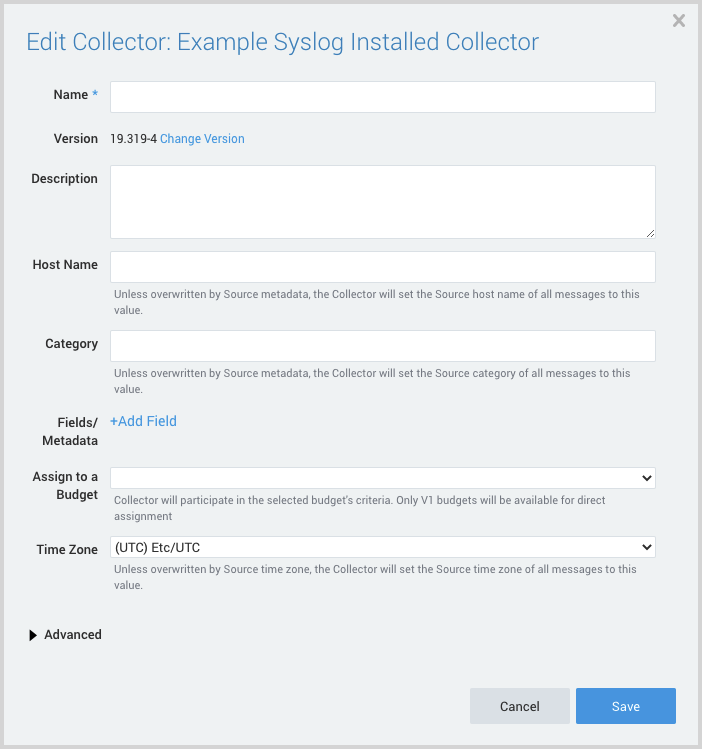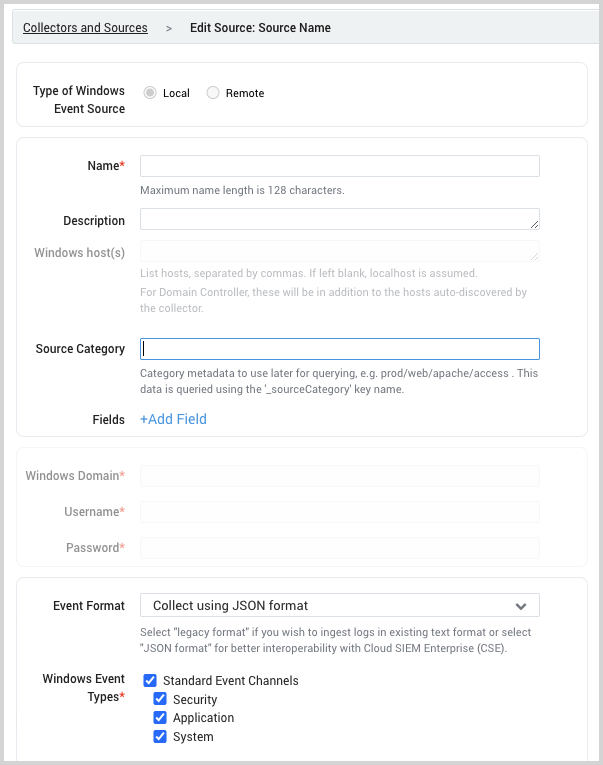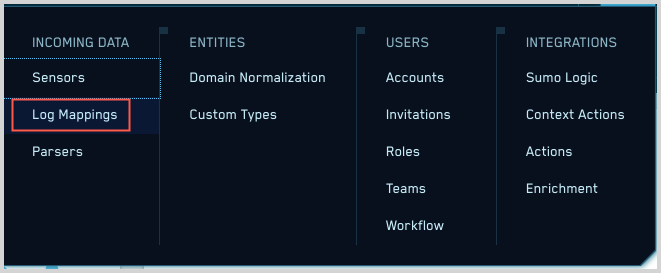Microsoft Windows - Cloud SIEM
Step 1: Configure collection
In this step, you configure a Local Windows Event Log Source to collect Microsoft Windows Event Log messages. You can configure the source on an existing Installed Collector or create a new collector. If you’re going to use an existing collector, jump to Configure a Local Windows Event Log Source below. Otherwise, create a new collector as described in Configure an Installed collector below, and then create the Local Windows Event Log Source on the collector.
Configure an Installed Collector
- In the Sumo Logic platform, select Manage Data > Collection > Collection.
- Click Add Collector.
- Click Installed Collector.
- The Add Installed Collector popup appears.
- Download the appropriate collector for your operating system.
- Install the collector. For instructions for your preferred operating system and method of installation, see Installed Collectors.
- Once the collector is installed, confirm it is available on the Collection page and select Edit.
- The Edit Collector popup appears.

- Name. Provide a Name for the Collector.
- Description. (Optional)
- Category. Enter a string to tag the output collected from the source. The string that you supply will be saved in a metadata field called
_sourceCategory. - Fields.
- If you are planning that all the sources you add to this collector will forward log messages to CSE, click the +Add Field link, and add a field whose name is
_siemForwardand value is true. This will cause the collector to forward all of the logs collected by all of the sources on the collector to CSE. - If you are planning that all sources you add to this collector will use the same log parser (if they are the same type of log), click the +Add Field link, and add a field whose name is
_parserwith the value /Parsers/System/Microsoft/Windows-JSON. This will cause all sources on the collector to use the specified parser.noteIt’s also possible to configure individual sources to forward to CSE, as described in the following section.
- If you are planning that all the sources you add to this collector will forward log messages to CSE, click the +Add Field link, and add a field whose name is
Configure a Local Windows Event Log Source
- In Sumo Logic, select Manage Data > Collection > Collection.
- Navigate to the Installed Collector where you want to create the source.
- Click Add Source next to the Installed Collector.
- Select Windows Event Log.
- The page refreshes.

- Name. Enter a name for the source.
- Description. (Optional)
- Source Host. (Optional) Enter a string to tag the messages collected from the source. The string that you supply will be saved in a metadata field called
_sourceHost. - Source Category. Enter a string to tag the output collected from the source. The string that you supply will be saved in a metadata field called
_sourceCategory. - Fields.
- If you have not configured the Installed Collector to forward all sources in the collector to CSE, click the +Add Field link, and add a field whose name is
_siemForwardand value is true. - If you have not configured the Installed Collector to parse all sources in the collector with the same parser, click the +Add Field link, and add a field whose name is
_parserwith the value /Parsers/System/Microsoft/Windows-JSON.
- If you have not configured the Installed Collector to forward all sources in the collector to CSE, click the +Add Field link, and add a field whose name is
- Event Format. Select Collect using JSON format.
- Windows Event Types. Select the desired event types. You can also specify Custom Event Channels in the box below.
- Event Collection Level. Select Concise Message.
- Security Identifier. You may specify how you want the Security Identifier (SID) to appear in the log message, Username Only is the default option.
- Collection should begin. Specify when you want the log collection to start.
- Click Save.
Step 3: Verify ingestion
In this step, you verify that your logs are successfully making it into CSE.
- Click the gear icon, and select Log Mappings under Incoming Data.

- On the Log Mappings page search for "Windows" and check under Record Volume.

- For a more granular look at the incoming records, you can also use search the Sumo Logic platform for Windows security records.
